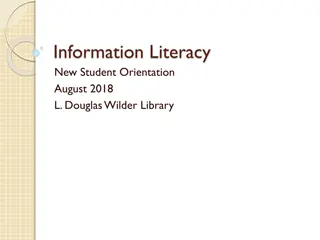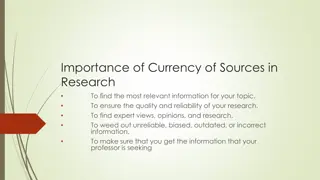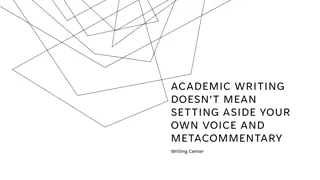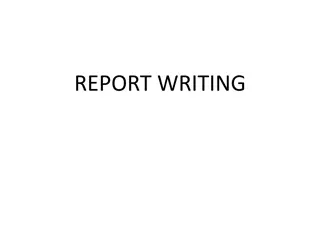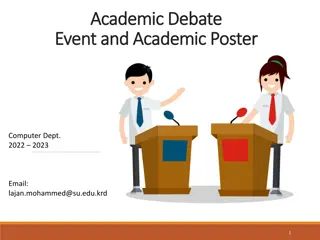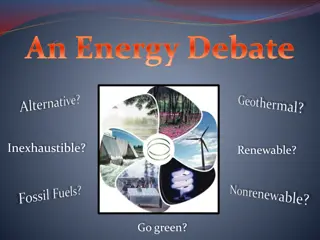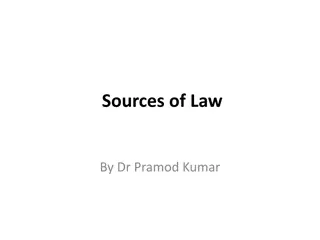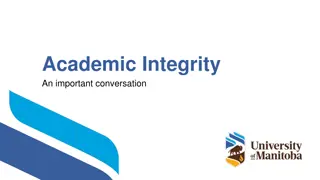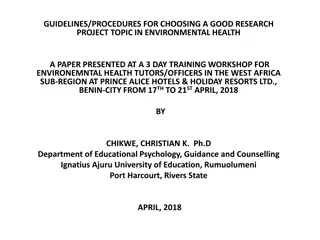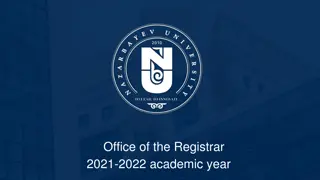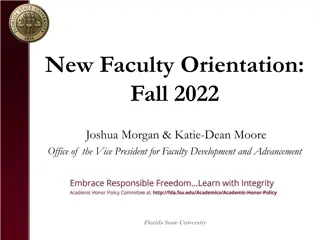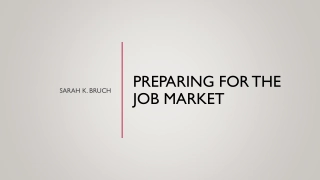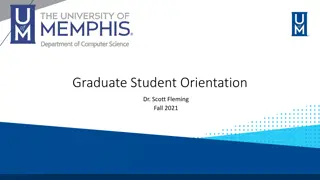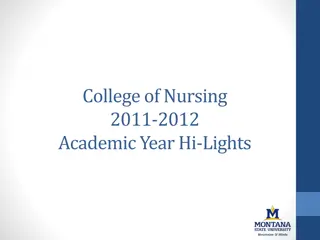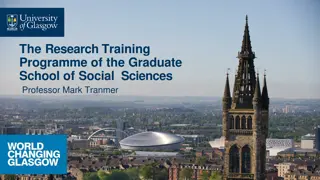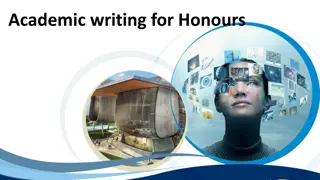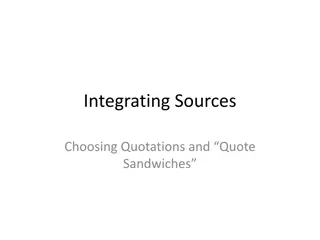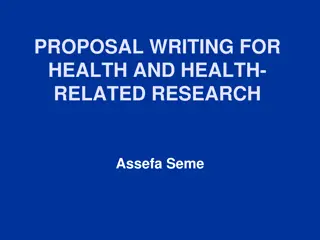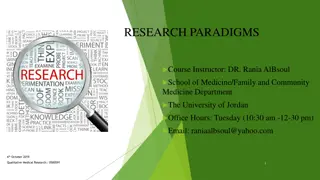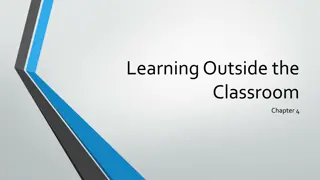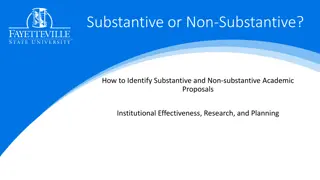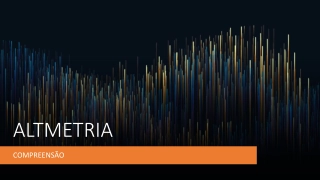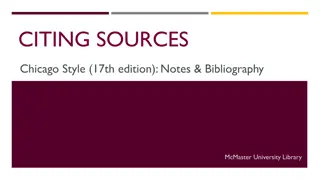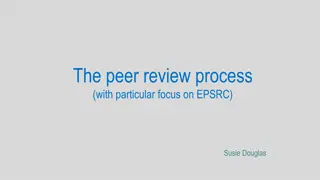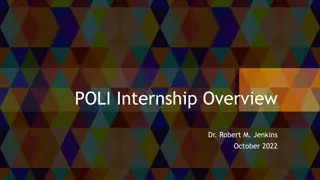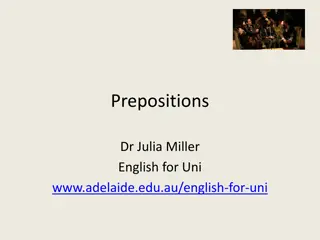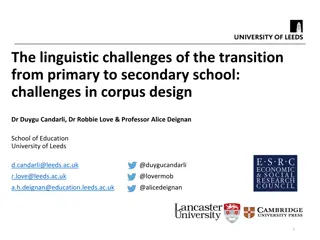Understanding Academic Sources for Effective Research
Explore the differences between books, journals, newspapers, and magazines to enhance your assignment research. Learn how scholarly and popular sources differ in content, audience, and purpose for better citation practices.
Download Presentation

Please find below an Image/Link to download the presentation.
The content on the website is provided AS IS for your information and personal use only. It may not be sold, licensed, or shared on other websites without obtaining consent from the author. Download presentation by click this link. If you encounter any issues during the download, it is possible that the publisher has removed the file from their server.
E N D
Presentation Transcript
Choosing Academic Sources NWSS Library Blatantly stolen from UVic Libraries
Books, Journals, Newspapers, Magazines For your assignments, you'll typically consult and cite a mix of books, journals, newspapers and magazines. Knowing the difference will help you determine the most relevant and useful sources for your assignment.
A Comparison Books Journals, newspapers and magazines In-depth and broad examination of a topic. May be in-depth -- usually on a specific topic. Longer lag between an event or discovery and a book's publication. As a result...More complete information (causes, effects, long-term consequences, fuller conclusions, etc.). Deeper analysis. Broader historical perspective; more context both within and outside of a discipline. Cover recent developments and events with little time lapse. As a result...Information is current but may be incomplete. Captures "the spirit of the moment" (especially newspapers and magazines). Journals are important for reporting fast-paced, competitive or time-sensitive research.
A Comparison Books Journals, newspapers and magazines Contain original research that may cover multiple experiments or span several years. Journals contain original research and typically focus on one experiment; newspapers and magazines may refer to research studies, but do not contain original research. More cumulative coverage of a topic. Limited coverage without much historical overview or context. Longer: 100 to several hundred pages. Shorter: a few hundred words (newspaper articles) up to around 30 pages (journal articles). Published once, though revised editions may come out later. Composed of volumes and issues published regularly.
Scholarly or Popular Sources "Scholarly" or "popular" are terms used to describe a source's content, purpose, audience, appearance, citations and more. Popular sources are useful for getting ideas for a topic or for background and anecdotal information. Typically, however, you should support your arguments by citing scholarly articles, which contain original research written by experts and do not contain glossy pages or advertisements. Ask your instructor or the teacher-librarian if you're unsure about citing a source.
A Comparison Scholarly Sources original research published in journals Popular Works general interest stories which may refer to research but do not contain original research written by experts in the field written by the general public are usually peer-reviewed (evaluated by other experts in the same field) are not peer-reviewed include citations rarely include citations usually are longer, about 10-30 pages tend to be shorter, about 200 words to a few pages
What's a Journal? A journal is a scholarly publication containing articles written by researchers, professors and other experts. Journals focus on a specific discipline or field of study. Unlike newspapers and magazines, journals are intended for an academic or technical audience, not general readers.
Journals Journals are published on a regular basis (monthly, quarterly, etc.) and are sequentially numbered. Each copy is an issue; a set of issues makes a volume (usually each year is a separate volume). Like newspapers and magazines, journals are also called periodicals or serials.
How do I Access Journals http://www.nwsslibrary.ca/online-databases/ Please refer to the online database lesson for more information Please note these databases are password protected. Please email a teacher-librarian for the usernames and passwords.
Primary or Secondary Sources When doing research, it is usually advisable to use a mixture of primary and secondary sources
Primary or Secondary Sources What is a primary source? What is a secondary source? A document or record containing first-hand information or original data on a topic Any published or unpublished work that is one step removed from the original source, usually describing, summarizing, analyzing, evaluating, derived from, or based on primary source materials A work created at the time of an event or by a person who directly experienced an event A source that is one step removed from the original event or experience Some examples include: interviews, diaries, letters, journals, original hand-written manuscripts, newspaper and magazine clippings, government documents, etc. A source that provides criticism or interpretation of a primary source Some examples include: textbooks, review articles, biographies, historical films, music and art, articles about people and events from the past
Evaluating Primary Sources Another way to look at primary sources is to evaluate them according to the standards of Authority, Accuracy, Accessibility, Purpose, and Bias. These standards can be applied to any source, primary or secondary, and they are very useful in determining the usefulness of a primary source.
Evaluation of Primary Sources Standard Questions to be answered Authority: Who created this source? What was that person's involvement? How does the author know these details? Was that person present at those events, and if so, in what role? Where does this information come from: personal experiences, research, data gathered by others? How accurate is this source, if I compare it to other first hand accounts? If I compare it to second hand accounts? Where did this source come from: a library, an archives, the web? How trustworthy is the source? Was it edited? How did it survive? Why was this source created? Why was it later published? Was it meant to be kept private or was it intended for publication? Every document is biased, to some extent, by the point of view of its creator. Some documents are heavily biased, on purpose (speeches, propaganda, political cartoons). What bias do you discern in the source, and where did it come from? Did it serve a purpose or was it accidental? Accuracy: Accessibility: Purpose: Bias:
Evaluating Websites If you want to cite websites in academic work, you will need to be more critical of the content than you might be for casual internet use. You will be using the CRAAP Test Worksheet
The CRAAP Test C - Currency R - Relevance A - Authority A - Accuracy P - Purpose *The CRAAP Test was developed by California State University, Chico
Currency When was this information published? Is it recent enough to be used for your research or thesis? Has newer information since been updated? (E.g. new science discoveries, updated language, etc.) If it s a website: when was it last updated?
Relevance Does the information relate to your topic or question? Is the information at an appropriate level? Would you be comfortable using this source for a research paper?
Authority Who is the author, writer, or creator? What are the author s credentials or organizational affiliations? (E.g. are they writing for the government? Educational institute? Health organization? Non-profit organization? etc.) What qualification do they have to write on this topic? *Websites only: does the URL reveal anything about the author or source? (e.g. .com, .edu, .gov, .org, etc.)
Accuracy Is the information supported by evidence, or are they opinions? Does it include any citations or a bibliography? Are there any spelling, grammar, or other typographical errors? *Websites only: do all the links work?
Purpose Is the intent of the author or creator clear? Why are they writing this piece? Does the point of view appear objective and impartial? Are there any political, ideological, cultural, religious, or personal bias? Is the creator/author trying to advertise something?
Google Scholar Google Scholar searches: peer-reviewed articles, books, reports, theses, preprints, abstracts, technical reports, conference papers and more.




